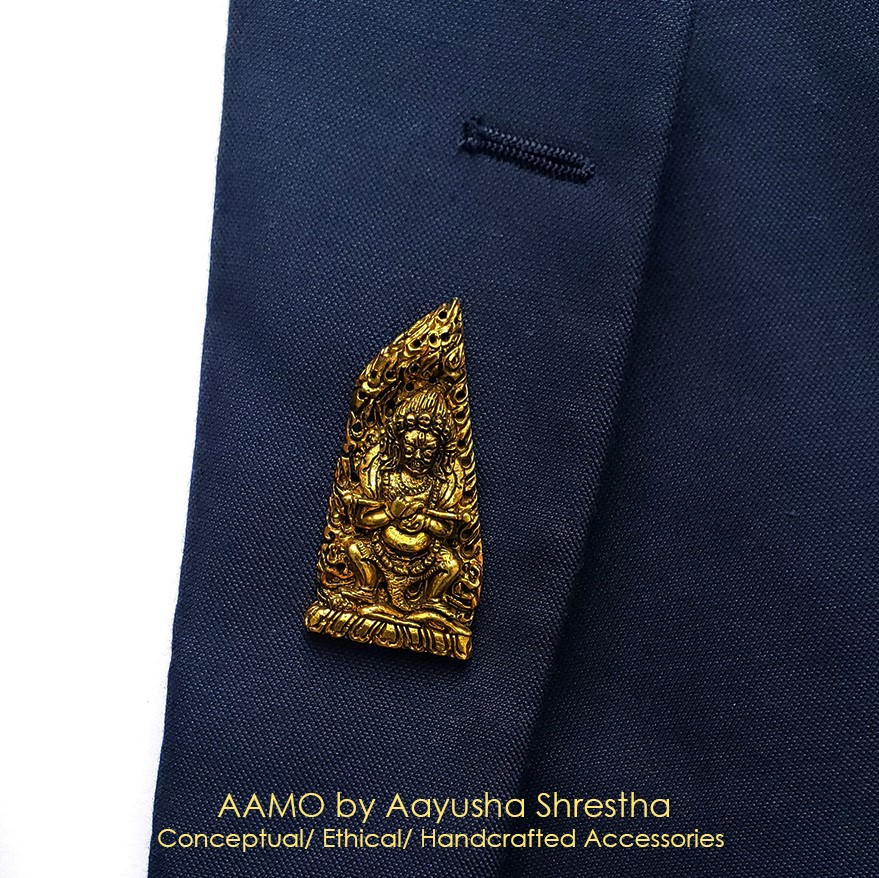Although found in abundance in the shops in and around Kathmandu, most local people are not aware of the importance of singing bowls.
The mighty Boudha stupa towered in front of me emanating enduring silence and peace. Its vicinity, however, was absolute pandemonium. I felt it was more about perspective and tuning in because a little later, the same pandemonium became nothing less than a song, humming its own tune.

“Drei hundered, sir,” trailed the lady’s voice following a westerner who initially interested in her singing bowl for some reason, had now chosen to walk away. As the tourist walked away, with increasing distance between them, the pitch in her voice receded along with the price, clearly indicating her desperation to sell the product. I had just entered the encircling walkway of the stupa in search of a singing bowl therapist and here was this lady who, without appointment, served as a prelude to my assignment. Singing bowl in this lady’s hand; singing bowls in every temporary establishment; singing bowls in souvenir shops and I read a good number of shop names with singing bowls written on them. Now, that I was really looking for one, I was seeing them; in numbers I could not believe. I had been here on many sunny days and on several full moon nights and had even managed to stroll by the shops but amazingly, never spotted a singing bowl. “The eyes really have it this time,” I said to myself as I moved ahead looking for more of its kind.
Although found in abundance in shops around Kathmandu, most local people are not aware of the importance of singing bowls. But singing bowls produced in Nepal have found their way to the west, and there is keen interest among westerners. It has been able to carve its own niche not just as a musical instrument, but more so as a very effective medium for meditation and healing. Initially discovered by spiritual tourists, the bowl found its way through them to Europe and the United States, and was much sought after for its sound phenomena. With time and practice, and also after observing the end results, this instrument became a tool for therapy. The vibration produced by the instrument has given it an edge over other instruments for therapeutic use. In Nepal, apart from being used as a bowl for food and in some cases for performing rituals, it is merely looked upon as a souvenir for tourists.
History
It is believed that singing bowls originated in a place called Kham in Tibet. The popular belief is that singing bowls are found in all the places the Tibetans immigrated to viz., Nepal, Bhutan and northeast India. However, the Devnagri scripts on some of the oldest singing bowls that have been found, suggest that the bowls originated in Nepal and are only known as Tibetan bowls because the Tibetan refugees traded not only the goods they brought with them, but also artifacts found in Nepal.
Another notable belief is that the bowl was originally built for eating purposes. Harsha Ratna Shakya, a third generation singing bowl trader reminisces, “As far as I know, it has only been forty years since it came to be known as a singing bowl. Otherwise, it was called ‘dabaka’, meaning ‘bowl’.” However, this ‘dabaka’ was made chiefly of copper as the Nepalis strongly believed the metal to be good for health. They still do. So, while the ‘dabakas’ were made keeping the good health of people in mind, the singing bowls are made considering the production of sound. In other words, all ‘dabakas’ are good bowls to eat from, but all singing bowls are not good to eat from.
Later, this bowl became an important tool for therapy. This dates back to the time when there were no doctors or medicines to cure problems like backache or chest pain. In such situations, the bowl would be placed on the chest or back of the patient and then stroked for its vibrations. All opinions regarding who made the first singing bowls, points to Shamanistic traditions, as use of sound is prevalent in Shamanism. Other theories exist with accounts of traveling smiths and monks as metal workers.
Composition
Traditionally, the bowl is made up of eight metals viz., copper, tin, lead, zinc, iron, gold, silver and mercury. However, only seven metals are mentioned, as mercury is a liquid and was not counted as a metal. Nowadays, such bowls exclusively used for therapy and meditation are rarely produced. The traditional method of hammering solid metal into the shape of a bowl has not been in use for more than forty years. An eating dish made of metal is very difficult to clean so they have been replaced by earthenware. If the dishes were used for sacrificial rituals, the Chinese invasion of Tibet, leading to destruction of many monasteries, dramatically ended the demand for sacrificial dishes.
The bowls being produced today are mostly made using a cast and comprise of five metals minus the gold and silver. The true Tibetan bowl is made with more silver and tin, giving it a dull, anthracite luster, while bowls made in Nepal have the familiar golden glow.
Singing bowls as musical instruments
Santa Ratna Shakya is an expert on singing bowls by many virtues: in identifying the value, composition and characteristics of the bowl; as a performer using the bowls as musical instruments; as an effective medium in meditation and as a healer using the bowls for therapy. Developing upon the inherited knowledge and techniques, he went on to concert performances. Over the years, as the emphasis on holistic living increased, demand for this type of healing went up, and therefore his visits to the west became more frequent. Shakya informs, “Performing on singing bowls is like playing a piano.” For this, he mixes the new and old bowls as the big old bowls produce flat notes while the new ones give sharp notes. “The lack of gold and silver in the new bowl composition,” he says, “creates a sound with a lot of variation and is thus very good for musical performances. The new bowls are high pitched and this makes them good for concert performances, but cannot be used in therapy for the same reason.” It has been found that singing bowls and other ritual artifacts such as bells, gongs and cymbals produce far more natural harmonics than many other musical instruments. This is chiefly because every metal used in the bowl produces an individual sound, including harmonics, and together these sounds produce the exceptional ringing sound of the bowl.
Meditation
Meditation means mind concentration and it is easier to concentrate with a medium than without it. When a bowl is sounded in one’s hand, vibrations and thus sound is produced. It is these two factors that make concentration easier. That is why it is also called the ‘meditation bowl’. If a person is unable to concentrate even after five to ten minutes, then the use of a singing bowl is highly recommended. The bowl was used for therapy, why was it later used for meditation? Among the wave patterns of different singing bowls there is a measurable wave pattern, which is equivalent to the alpha waves produced by the brain. Information in the brain is transmitted through ‘neurons’, which are connected to transmit nerve impulses. This transmission uses the electro-chemical properties of the cells to transmit rapid communication waves. It could be that the freely moving vibration produced by the singing bowls stimulates the neurons to make more connections, in which case one’s consciousness is being increased.
Synchronization, Inner Massage and Therapy
Singing bowls are increasingly being used in therapy mainly for their vibration. The vibrations spread quickly through our body, and this results in a very delicate internal massage of all the cells. Physiotherapists are also known to make use of this internal massage via ultra-sonic sound waves.
Personally, I found the therapy to be a very relaxing experience with sound as a medium, which can transport one to a different realm. As much as you feel drawn into this different world and realities, you are also aware of the changes in your body as the muscles gradually and automatically relax. It is then, that we realize how stiff we are, and how much capacity we have to relax our muscles and body, all for one’s own well-being. Sometimes the sound instills a feeling of limitless space and peace. In simple words, it is all about opening and closing of the energy chakras using sound and vibration therapy.
The human body being a living entity of vibrations is believed to be vibrating only at its own frequency, when healthy. In other words, the frequency of a sick organ is disturbed. Singing bowls (as well as gongs and tingshaws) are believed to recreate the original harmonic frequency, and stimulate the body to rediscover its own harmonic frequency by making it vibrate independently. It is found that the body is able to tune in to its own undisturbed frequency after being stimulated and taken up by the powerful vibrations of the singing bowl.
Sergio Carvalhal, a businessman from Rio de Janeiro met a healer named Nar Bahadur Dhakal six months ago. He has had two sessions of healing with Dhakal and is very satisfied. “It makes me feel very happy. I sometimes feel as if I’m above the ground during therapy,” says Sergio, looking relaxed after a fifty-minute session.
Characterization and Identification
Color has no effect on the sound as some of these bowls have a dull black layer of varnish, usually on the outside. This layer is meant to be there and does not interfere with the sound. However, if you buy a matt bowl and polish it, this can influence the sound. The sound is determined by the shape and thickness of the material, as well as by the thickness of the rim. By polishing the bowl, the thickness of the metal is permanently altered.
Although singing bowls are popularly known as ‘Tibetan bowls’, it is also to a lesser extent, known as ‘Nepalese Bowls’. They can be otherwise called ‘Himalayan Bowls’. Bowls with a stand are generally quite small and are rather rare, while bowls with a so-called ‘bottle base’ are mainly made in India. They are fairly thin, and produce a different sound from that of the ‘Himalayan bowls’.
Most bowls are decorated nowadays, using the process of etching. Sometimes there is an inscription on the outside, indicating the name of the owner or the ceremony for which the bowl was used. Some bowls, especially those engraved with patterns, may react like Chinese fountain bowls. When they are filled with water up to the engraved ring and are vibrated by striking or rubbing them, one or more fountains can arise.
Tools
Normally, a gong beater is used to produce singing tones in singing bowls, but one can also use the heel of the hand, the fingers and the nails. As a rule, a larger gong beater will produce the full richness of sound in a large bowl, while it is better to use smaller beaters for the smaller bowls. In fact, every beater produces a different sound from the range of the basic note and its harmonics.
Another popular way to set the tones in the bowl ringing is to rub a hard stick around the rim of the bowl. A full singing tone is heard and steadily increases in volume. If the stick is thin, the tone produced will be naturally high. The pressure and the speed at which the bowl is rubbed have an influence on the sound and the pitch of the tone produced. The penetrating ringing sound is created because rubbing of the bowl in this way accentuates and develops one of the harmonics.
The search for ‘the one’
In order to find a singing bowl suitable for yourself, you should go for a bowl that will ‘touch’ you. It is rather hard to explain the real meaning of this word in the context of a singing bowl, but to describe it briefly, it is a warm, positive feeling that will flow through the body on hearing its ringing tone. Thereafter, the mere ‘delightful beauty’ of the sound, you may have otherwise heard from other bowls, does not matter. The bowl with the capacity to carry you away has a liberating effect and is much sought after by sound therapists. Many unable to go by intuition go for methods to find the bowl. Basically, the bowl’s suitability for you depends on the signals as a reflection of the bowl’s vibrations, as it indicates that you are in harmony with the bowl.
Every person is a unique sounding board and will make the bowl resonate in a completely different way. That is why, the same bowl will resonate differently for different people. Every person changes from one moment to the next, both physically and spiritually, and therefore the same bowl will sound different at different times. With some people the higher notes resonate longer, with others the higher notes fade quickly and the lower notes continue for a longer period.
Singing bowls are usually sold by weight, which means heavier the bowl, the more expensive it gets. When buying singing bowls, one must also keep in mind that many of those sold on the streets are made of not more than three metals, if not of a single metal. Moreover, the bowls used for therapy are rather plain compared to the commercially produced ones.
As I left the premises, I could still see the lady performing with the bowl in her hand and could not stop mulling on the endless strength and quality of that simple bowl. It was only left for the ones who had been ‘touched’ to discover its limitless positive energy, with patience and time. It is indeed a truly ‘magical’ experience for those who have found it!
(Source: “Singing Bowls” by Eva Rudy Jansen. Much information has also been gathered through meaningful conversations with people in the trade.)

More than just your usual lapel pins
The lapel pin is a men’s accessory worn on the lapel of the jacket which serves as a...










